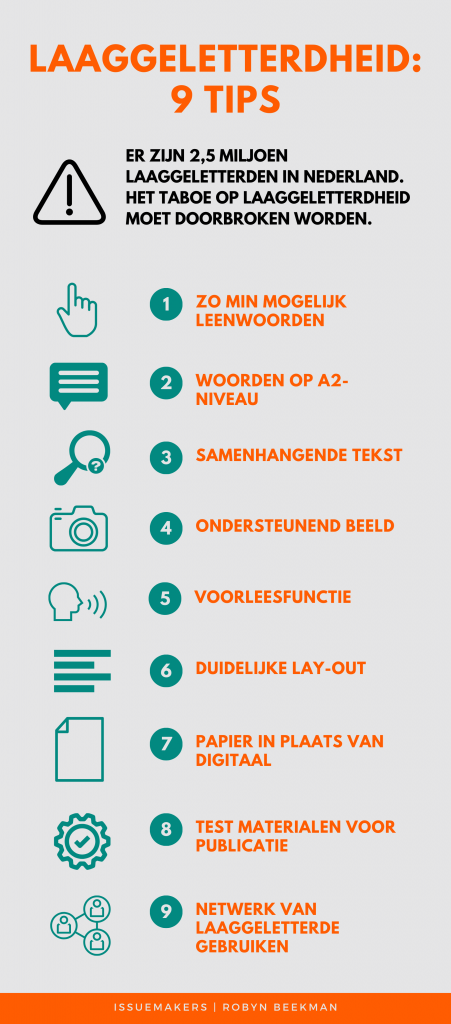
Understandable communication: this is how you do it
By Robyn Beekman, master's student of Dutch Studies and intern at Issuemakers
How many low-literate people do you know? 66% of the Dutch people do not know anyone who has low literacy. Yet there are as many as 2.5 million people in the Netherlands who have low literacy.
Low literacy and health literacy
Someone who has low literacy has difficulty with digital skills, language and arithmetic, for example. In today's knowledge society, in which everything has to be faster and more efficient, a person can function less well in everyday activities. The percentage of low-literate people in the Netherlands has increased in recent years. This is partly due to an aging population, an increase in low literacy among young people and an increasing number of newcomers.
Low literacy has far-reaching consequences. Not only for people themselves, but also for society. People who have low literacy are less likely to find a job, have less control over finances and are less likely to live a healthy life. People with low literacy also visit the doctor and hospital more often. People with low literacy even have a 1.5 greater chance of premature death, because they have less knowledge of diseases and treatment plans. In addition, dangerous situations can arise when someone does not properly understand a package leaflet and therefore does not take a medicine correctly.
People who have low literacy often have difficulty with health skills. This is about obtaining, understanding, assessing and using health information. The issue of health literacy has received attention relatively recently and there are taboos surrounding low literacy. For example, the problem is little known to doctors. People with low literacy are ashamed and do everything they can not to have to be confronted with it.
Corona communication
In a pandemic like the one we are in now, it is extremely important that everyone in society is reached with the right information. This can only be done by providing understandable information. That is why I have been researching low literacy and health communication for Issuemakers over the past three months. How can you make communication more understandable and how can you reach people with low literacy? The poster 'Low literacy: 9 tips' offers concrete tools in this regard. The tips concern language, layout, medium and reach. They are based on my literature research and interviews with experts from the Ministry of Health, Welfare and Sport, the Reading and Writing Foundation, Pharos and the ABC Foundation.

At word level, tips 1 and 2 are important: avoid loan words and use as many words as possible A2 level (comparable to the level of a VMBO English exam). It is important to use as few loan words as possible, because they are more difficult to understand. The Reading and Writing Foundation recommends writing at level A2, although the government must write at level B1. With level A2 you reach about 95 percent of the people. To test whether a word is A2, you can use a tool such as Find simple words [1].
Comprehensible words alone are not enough. It is also important that your text is coherent (tip 3). You achieve this by signal words use to connect sentences. Since many people with low literacy have difficulty reading a lot of text, it is important that there is a supporting image and a reading function (tips 4 and 5). A person with low literacy looks at an image first, so image and text must say the same thing. In addition, people who are not illiterate also benefit greatly from images. A reading function can then help someone to understand the text. Some people with low literacy understand something better when they listen to it.
In addition to a coherent text, supporting image and a reading function, it is important to pay attention to the layout of your text (tip 6). This includes short sentences, sentences on new lines, subheadings, clear and large fonts, numbers in numbers and contrasting colors. The layout is also important for the medium you use. A person with low literacy always prefers paper, because it does not require digital skills (tip 7).
Before you publish a text, it is important that you have it tested by your target group (tip 8). They provide a necessary perspective on whether your message is received well and whether you are offering the right information. If this is impossible, you can use tools to test the understandability of your text, for example the Checklist of accessible information [2]. People with low literacy often have difficulty finding information themselves, so it is important that information comes to them. This is where someone's network works best (tip 9). Organizations such as Pharos, the Reading and Writing Foundation and the ABC Foundation are good starting points: they have a large network of low-literate people.
Everyone benefits from understandable communication
In short, the issue of low literacy is a major one. You need language for a lot of care and it is - especially now - extra important that everyone in society is reached with essential information. Low-literate people are therefore not only a vulnerable group in society, but are also a larger group than you think. It is therefore important that every organization takes low-literate people into account as (part of) the target group. You can only do this by communicating in an understandable way, something that benefits everyone. Hopefully the poster will help you with that.
Tools:
[2] Checklist accessible information



